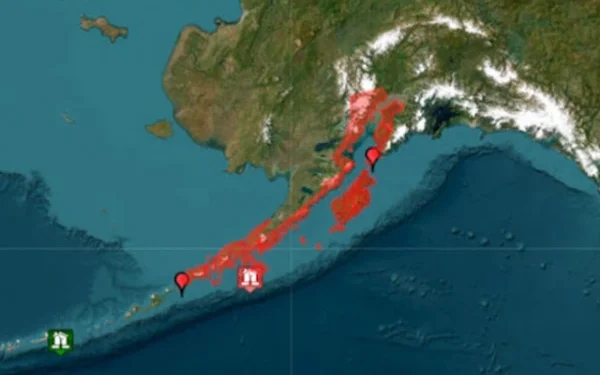Introduction: Major Earthquake Rattles Southern Alaska
A strong earthquake with a magnitude of 7.3 struck near Sandpoint Island in Alaska, sending shockwaves across the region and prompting authorities to issue a tsunami warning for nearby coastal areas. The tremors were widely felt on Popov Island and surrounding communities, triggering fear and urgent evacuations to higher ground.
According to the United States Geological Survey (USGS), the earthquake struck approximately 54 miles south of Sandpoint, in the Aleutian Islands chain. The event occurred at a significant depth, and despite its remote location, it caused panic among local residents due to its sheer intensity and potential for generating a tsunami.
Geographic Location and Epicenter Details
Sandpoint is located on Popof Island, part of the Shumagin Islands in the Aleutian archipelago of southwestern Alaska. The area is known for its high seismic activity, lying along the Pacific “Ring of Fire”, where several tectonic plates converge.
According to data from the USGS:
- Magnitude: 7.3
- Location: 54 miles (87 km) south of Sandpoint, Alaska
- Depth: Approximately 21 miles (33 kilometers)
- Coordinates: Near 54.5°N latitude and 159.7°W longitude
- Time of Occurrence: The quake struck at around 10:48 PM local time
The depth and location of the quake are key indicators of its potential for destruction. Earthquakes at intermediate depths such as this can still cause substantial shaking, especially when close to populated areas.
Immediate Tsunami Warning Issued
Shortly after the quake, the National Weather Service (NWS) and the National Tsunami Warning Center (NTWC) issued an official tsunami warning. This alert covered a wide range of coastal regions including:
- Southern Alaska
- The Alaska Peninsula
- Kennedy Inlet
- Unimak Pass
The NWS stated that tsunami waves between 1 and 3 feet could reach shorelines, potentially inundating low-lying coastal areas and endangering lives and infrastructure. Emergency sirens were activated in some communities, and local law enforcement began urging people to move to higher ground immediately.
Widespread Panic Across Islands
The tremors were strongly felt on Popov Island and neighboring islands, prompting widespread panic. Eyewitness accounts from residents describe intense shaking that lasted for several seconds, causing items to fall from shelves, minor structural damage, and temporary power outages.
Residents, fearing a tsunami, quickly evacuated to elevated areas. Videos shared on social media platforms showed people rushing through the streets at night, gathering emergency supplies, and congregating on hillsides or official tsunami shelters.
Local resident Carla Denali of Sandpoint told Alaska Public Radio:
“It was terrifying. The ground just kept moving, and we could hear things crashing in nearby homes. Everyone started running toward the high school, which is on higher ground. We’ve had quakes before, but this one was really strong.”
Emergency and Rescue Services on High Alert
Following the earthquake, emergency services were immediately activated. Alaska’s Division of Homeland Security and Emergency Management coordinated with local first responders, tribal leaders, and coast guard units to assess damage and ensure public safety.
The Federal Emergency Management Agency (FEMA) was also notified and placed on standby in case federal assistance was needed.
Search and rescue teams began deploying drones and helicopters at daybreak to assess remote islands and check for injuries or infrastructure damage. Coastal surveillance was intensified to monitor wave activity and any unusual oceanic disturbances that might indicate a tsunami’s approach.
Authorities Issue Safety Guidelines
Local governments, in coordination with federal agencies, issued public safety advisories urging people to:
- Avoid coastal areas until further notice
- Move to higher ground in the event of a tsunami warning
- Monitor radio, television, and official social media channels for updates
- Pack emergency go-bags including food, water, medications, and important documents
- Report damage or injuries to emergency hotlines
The Alaska Earthquake Center emphasized that residents should also be prepared for aftershocks, which are common following a major seismic event of this magnitude.
Seismic History of the Region: Why Alaska Is So Earthquake-Prone
Alaska is one of the most seismically active regions in the world, experiencing thousands of small tremors each year. This is due to its location along the boundary between the Pacific Plate and the North American Plate, where tectonic movement frequently causes earthquakes and volcanic activity.
Notable past earthquakes in Alaska include:
- 1964 Great Alaska Earthquake (Magnitude 9.2): The second-largest earthquake ever recorded globally. It caused massive destruction and a deadly tsunami.
- 2021 Chignik Earthquake (Magnitude 8.2): A deep-sea earthquake near the same region as the current one, but without a major tsunami.
- 2018 Anchorage Earthquake (Magnitude 7.1): Caused widespread damage to roads and buildings in the state’s most populous city.
The current 7.3 magnitude quake, while not the largest, is still classified as major and has the potential to cause both localized damage and significant environmental impact, especially if a tsunami follows.
Scientific Analysis: What Caused the Earthquake?
Geologists at the USGS Earthquake Hazards Program explained that the quake likely resulted from subduction zone activity, where one tectonic plate is being forced beneath another. In this case, the Pacific Plate is subducting beneath the North American Plate at a rate of roughly 2 inches per year.
Such tectonic stress builds up over time and is suddenly released in the form of an earthquake. The geological complexity of the Aleutian subduction zone makes it difficult to predict when or where exactly such events will occur, but the region is constantly monitored by seismologists.
Dr. Helen Matthews, a geophysicist at the University of Alaska Fairbanks, elaborated:
“This earthquake fits within the expected seismic pattern of the Aleutians. While it’s always concerning when the magnitude crosses 7.0, the region is geologically prepared for it. The big unknown, as always, is whether it triggers a tsunami.”
Aftershocks Expected: Citizens Urged to Stay Alert
Following the main earthquake, aftershocks ranging from magnitude 3.5 to 5.1 were recorded by seismic monitoring stations. These smaller quakes are expected to continue for days or even weeks and could be felt across nearby islands.
The USGS has issued an aftershock forecast, indicating a 15% probability of another earthquake of magnitude 6.0 or greater occurring in the coming week. Citizens are urged to remain vigilant, avoid damaged structures, and follow official safety instructions.
Impact on Infrastructure and Transport
Initial reports suggest limited infrastructure damage, but assessments are ongoing. Some of the affected areas have interrupted power supply, minor landslides, and road cracks, especially on remote islands with limited access.
Airports in Sandpoint, Cold Bay, and King Cove were temporarily shut down for inspection but have since reopened with restricted flight schedules. The Alaska Marine Highway System has suspended ferry services in potentially impacted areas until the tsunami threat is fully lifted.
International and National Response
While the quake is being handled by local and state agencies, President of the United States was briefed on the situation by FEMA and the Department of Homeland Security. If needed, federal disaster assistance will be made available.
Nearby countries including Canada and Japan, which share Pacific coastlines and tectonic vulnerabilities, were also alerted by the Pacific Tsunami Warning Center (PTWC) as a precautionary measure, though no immediate threat was reported outside U.S. territory.
Conclusion: Ongoing Vigilance and Preparedness Crucial
The 7.3 magnitude earthquake near Sandpoint Island, Alaska, serves as a reminder of the unpredictable nature of seismic activity in the Ring of Fire. While prompt tsunami warnings and emergency responses have so far mitigated widespread damage, the situation remains fluid, and authorities continue to monitor for aftershocks and potential secondary effects.
Alaskans, well-versed in disaster preparedness, are once again showing resilience and community solidarity in the face of nature’s challenges. As scientists continue to analyze data and assess risks, public cooperation and ongoing vigilance will be key to minimizing harm and supporting recovery.

























